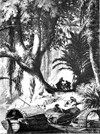Meeting 4 • 16 January 2014
|
Version: |
|
picture of the week
|
thought-bite of the week: "I reckoned that it was my duty… to record all the data obtained from reliable sources.… The further man is from civilization, the more he enjoys astonishing people…. He says he has seen what he imagines may have been seen by others."(Humboldt, "Personal Narrative", from Jaguars and Electric Eels, ed. & trans. Wilson, pp. 19 & 46) |
|
mini-text of the week (start): "At midday we stopped at a deserted spot called Algodonal.… I walked along the beach to observe a group of crocodiles asleep in the sun.… [M]y stroll almost cost me my life.… "Humboldt, "Personal Narrative", from Jaguars and Electric Eels, ed. & trans. Wilson, p. 74 (read more) |
course poster; course goals; overview of schedule; intake questionnaires (experiences; skills); Helferich, Humboldt & Stegner (e-)books; portraits of AvH; work sample: "Leaving Home"
|
(5')√ Thought-bite of the week (from week 1, actually): "Nature" - what does it mean? Where do you and others "find out" about "nature' and that unity? How does this relate to sustainability? |
|
(5')√ Mini-text of the week: Our own fearful encounters with fearsome, ferocious creatures |
|
(25')+ Speaking of fear: The quantitative ingredient of this course. English vs. metric; using our hands and feet to fathom the world (daycare center: "How big is [child]?"); telluric vs. planetary views / consciousness; moving over the surface of the world vs. looking at the Earth from space (one of you has blogged about how the technology of travel has changed our experience of the world through which we travel) So let's do a warmup before (next week) we SINQ the Humboldt Canoe quantatitively and maybe even actually: Small groups (4-8): Using the basic quantities worksheet, stage 1, generate (without using outside sources) the collective sense for these everyday quantities, which can then be used to do much more quantitatively. Report and compare the groups' quantities. Now go back into groups to use your quantities to determine these quantities (basic quantities worksheet, stage 2), which are examples of quantities Humboldt needed to work with constantly. Report and compare in plenary group. Next meeting you'll apply your quantities to determine some real-world (sometimes life-or-death) quantities needed by people who had to get across and around the globe in earlier times, and also some quantities that we encounter in discussions of sustainability. |
|
(5')√ Humboldt's travel routes through the "New World": route on the Orinoco and Amazon Rivers (0036); along and atop the Andes (0037); through Mexico (0038); . While you look at the map, think about the distances and what it meant to cover them on foot/ horseback / water. (NOTE: These maps are from the ink-on-paper Helferich biography of Humboldt; they aren't in the electronic editions.) The maps are linked from the Table of Contents frame of the main webpage. Soon you'll be using mobile apps to trace his route and examine the territory. |
|
(5')√ 20% of the way through the course - are we on course? Where are we on our course title? We've got AvH into exploring, but not into really doing science and not into sustainable environmentalism. |
|
(5')N The Weitsch porrait of AvH: relation to long tradition of portrait painting (and photography, including the pics you take of yourselves to express your identity/ies; the emergence of the scholar/ scientists as claimed co-equal of the ruler, churchman, soldier. |
|
(10')√ So what was I doing in Hawaii? Link to Lyon Arboretum; Arboretum Center & panorama; a threatened plant (plant; signage); professor as Humboldt in Lyon Arboretum; Cyanea humboldtiania: preservation & restoration (1361 sterile culture; 1359 closeup of culture with student intern; 1363 in storage with label; 1389 greenhouse sprouts; 1386 in the greenhouse, start of mature plant Foster Botanic Garden: 1461 sign "Cannonballs"; 1464 Cannonball tree; 1467 Cacao; 1470 Macadamia nut sign; 1471 coffee bush; 1474 urban surroundings a Hawaiian canoe; history of Bible in Hawaiian; sea asparagus and sustainable agriculture; possible upcoming activity: portraits of ourselves as environmentalist-explorers |
|
(5')√ Announcements and previews?? soon: we'll load and crew a mockup Humboldt Canoe; note also how I have annotated the outlines for previous meetings with comments about what happened during them |
|
Items not covered during the session but will come up eithe |
